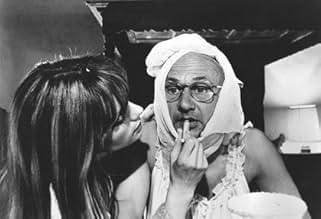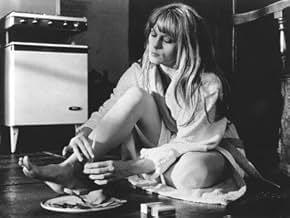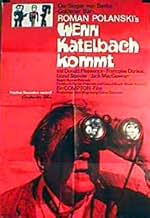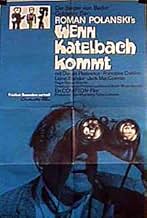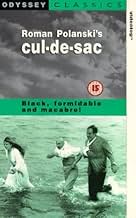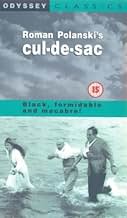Cul-de-sac
- 1966
- Tous publics
- 1h 52m
IMDb RATING
7.0/10
15K
YOUR RATING
In search of help, two wounded gangsters on the run find refuge in the secluded castle of a feeble man and his wife; however, under the point of a gun, nothing is what it seems.In search of help, two wounded gangsters on the run find refuge in the secluded castle of a feeble man and his wife; however, under the point of a gun, nothing is what it seems.In search of help, two wounded gangsters on the run find refuge in the secluded castle of a feeble man and his wife; however, under the point of a gun, nothing is what it seems.
- Director
- Writers
- Stars
- Nominated for 1 BAFTA Award
- 1 win & 1 nomination total
Jacqueline Bisset
- Jacqueline
- (as Jackie Bisset)
- Director
- Writers
- All cast & crew
- Production, box office & more at IMDbPro
Featured reviews
After their car becomes stuck on a causeway, two gangsters named Dickey and Albie find themselves stranded on the remote island of Lindisfarne. There, they take refuge in a castle owned by an eccentric couple, the mentally unbalanced George and his promiscuous and beautiful wife Teresa. The hoods proceed to hold George and Teresa hostage, until their boss Katelbach can send them some transportation off the rock. However, matters become complicated by the arrival of a group of George's friends, one of whom Teresa has an affair with. So begins 'Cul-de-sac,' a tale of madness, sexual frustration and pitch-black comedy that could only have come from the mind of Roman Polanski.
Original, abstract and frequently funny, Polanski's 'Cul-de-sac' is a fascinating, captivating movie that will delight any fan of the dark and strange. Much like his earlier 'Repulsion,' the film launches the viewer into a weird world populated by odd folk struggling with their desires and how to interact with the people around them. The characters engage in a power struggle throughout the film, with manipulation and thuggery being the prime weapons at their disposal. While the hoodlums take George and Teresa hostage, it is also Teresa who makes George a hostage of her lust, and it is she who does the most damage to his psyche.
It is a film that will likely spark differing opinions as to what the meaning of it all is. Some cinema-goers enjoy the guesswork, though others find abstractions infuriating; and 'Cul-de-sac' is not for the impatient or the shunners of philosophy. It's an intriguing, dark thriller that also happens to be one of Polanski's funniest outings, as he injects the narrative with much off-beat humor and sharp, banterous dialogue. The film still features his trademark examinations of paranoia, isolation and social unease; though told in a slightly lighter fashion than one accustomed to Polanski would expect (which, for this viewer anyway, comes as a boon to the proceedings).
'Cul-de-sac' is a visually enthralling flick, featuring arresting cinematography from Gilbert Taylor, who lent his talents to the previous 'Repulsion,' and would go on to work with Polanski once more on 'MacBeth.' Their collaborations made for undeniably artistic and powerful visuals that intrigue and impress, both in creative and technical terms. 'Cul-de-sac' boasts some incredible cinematography, from intense tracking shots to the masterful manipulation of light and shadows; Taylor's distinct and evocative work under Polanski's firm direction is unforgettable.
Alastair McIntyre was a frequent collaborator of Polanski's, and his editing for 'Cul-de-sac' is swift and smart. Reportedly, the two men toiled very closely together in the editing suite, developing over the years an intuitive and fruitful working relationship build on mutual respect and admiration. Looking at the remarkably tight, streamlined final cut of 'Cul-de-sac;' it's easy to see why Polanski utilized McIntyre on six films- his work is nigh on flawless.
Also of note is the score from Krzysztof Komeda, which is jazzy and strangely haunting; like elevator music from Dante's second circle of hell. His melodies fit perfectly the images of the film, as odd and as unsettling as some of them may be. Additionally, Bridget Sellers' rich costume design and George Lack's detailed set decoration and art direction lends the film additional impact and depth to the locales and characters.
'Cul-de-sac' stars Donald Pleasence as George, Françoise Dorléac as Teresa and Lionel Stander as Dickey, with the three of them turning in strong performances that are highlights in each of their filmographies. Pleasence is terrific as the unhinged, deeply neurotic George, imbuing him with an almost childlike quality which makes the character all the more interesting and odd. Though sometimes in films Pleasence had a tendency to go a little over-the-top, here he remains grounded, despite the weirdness of the role; doing consummate work that is hard to forget.
Dorléac- who tragically died before making it as big internationally as her sister Catherine Deneuve- is nothing short of a sensation as Teresa, giving a performance of wit, intelligence and depth that is a real treat to watch. As wily and as seductive as a panther in the night, Dorléac is not afraid to make Teresa unlikable, though she remains charismatic throughout. From her all too short career in film, Dorléac's assured performance in 'Cul-de-sac' is her greatest and most compelling.
Finally, Lionel Stander is brilliant as Dickey, the humorous hoodlum who takes hostage and tries to manipulate George and Teresa. Stander was a talented actor whose screen presence- like Ernest Borgnine- was such that you'd warm to him no matter what he did, evil or nay. With his crooked grin and gravelly voice, he leaves an indelible impression on the viewer; making Dickey a character that is most memorable. The supporting cast all perform admirably too, with a young Jacqueline Bisset and Jack MacGowran impressing the most.
Roman Polanski's 'Cul-de-sac' is a powerful and off-beat thriller that has a lot to offer viewers. Featuring an atmospheric Krzysztof Komeda score, stunning visuals from Gilbert Taylor and a cast performing at the top of their games; there is very little not to praise about the movie. If you enjoy films of abstractions and you have not seen it before, it is advisable that you do so now; as 'Cul-de-sac' is a weird, wild and wonderful movie that is not to be missed.
Original, abstract and frequently funny, Polanski's 'Cul-de-sac' is a fascinating, captivating movie that will delight any fan of the dark and strange. Much like his earlier 'Repulsion,' the film launches the viewer into a weird world populated by odd folk struggling with their desires and how to interact with the people around them. The characters engage in a power struggle throughout the film, with manipulation and thuggery being the prime weapons at their disposal. While the hoodlums take George and Teresa hostage, it is also Teresa who makes George a hostage of her lust, and it is she who does the most damage to his psyche.
It is a film that will likely spark differing opinions as to what the meaning of it all is. Some cinema-goers enjoy the guesswork, though others find abstractions infuriating; and 'Cul-de-sac' is not for the impatient or the shunners of philosophy. It's an intriguing, dark thriller that also happens to be one of Polanski's funniest outings, as he injects the narrative with much off-beat humor and sharp, banterous dialogue. The film still features his trademark examinations of paranoia, isolation and social unease; though told in a slightly lighter fashion than one accustomed to Polanski would expect (which, for this viewer anyway, comes as a boon to the proceedings).
'Cul-de-sac' is a visually enthralling flick, featuring arresting cinematography from Gilbert Taylor, who lent his talents to the previous 'Repulsion,' and would go on to work with Polanski once more on 'MacBeth.' Their collaborations made for undeniably artistic and powerful visuals that intrigue and impress, both in creative and technical terms. 'Cul-de-sac' boasts some incredible cinematography, from intense tracking shots to the masterful manipulation of light and shadows; Taylor's distinct and evocative work under Polanski's firm direction is unforgettable.
Alastair McIntyre was a frequent collaborator of Polanski's, and his editing for 'Cul-de-sac' is swift and smart. Reportedly, the two men toiled very closely together in the editing suite, developing over the years an intuitive and fruitful working relationship build on mutual respect and admiration. Looking at the remarkably tight, streamlined final cut of 'Cul-de-sac;' it's easy to see why Polanski utilized McIntyre on six films- his work is nigh on flawless.
Also of note is the score from Krzysztof Komeda, which is jazzy and strangely haunting; like elevator music from Dante's second circle of hell. His melodies fit perfectly the images of the film, as odd and as unsettling as some of them may be. Additionally, Bridget Sellers' rich costume design and George Lack's detailed set decoration and art direction lends the film additional impact and depth to the locales and characters.
'Cul-de-sac' stars Donald Pleasence as George, Françoise Dorléac as Teresa and Lionel Stander as Dickey, with the three of them turning in strong performances that are highlights in each of their filmographies. Pleasence is terrific as the unhinged, deeply neurotic George, imbuing him with an almost childlike quality which makes the character all the more interesting and odd. Though sometimes in films Pleasence had a tendency to go a little over-the-top, here he remains grounded, despite the weirdness of the role; doing consummate work that is hard to forget.
Dorléac- who tragically died before making it as big internationally as her sister Catherine Deneuve- is nothing short of a sensation as Teresa, giving a performance of wit, intelligence and depth that is a real treat to watch. As wily and as seductive as a panther in the night, Dorléac is not afraid to make Teresa unlikable, though she remains charismatic throughout. From her all too short career in film, Dorléac's assured performance in 'Cul-de-sac' is her greatest and most compelling.
Finally, Lionel Stander is brilliant as Dickey, the humorous hoodlum who takes hostage and tries to manipulate George and Teresa. Stander was a talented actor whose screen presence- like Ernest Borgnine- was such that you'd warm to him no matter what he did, evil or nay. With his crooked grin and gravelly voice, he leaves an indelible impression on the viewer; making Dickey a character that is most memorable. The supporting cast all perform admirably too, with a young Jacqueline Bisset and Jack MacGowran impressing the most.
Roman Polanski's 'Cul-de-sac' is a powerful and off-beat thriller that has a lot to offer viewers. Featuring an atmospheric Krzysztof Komeda score, stunning visuals from Gilbert Taylor and a cast performing at the top of their games; there is very little not to praise about the movie. If you enjoy films of abstractions and you have not seen it before, it is advisable that you do so now; as 'Cul-de-sac' is a weird, wild and wonderful movie that is not to be missed.
This film is incredible. Polanski's best film behind Knife in the Water and Rosemary's Baby.
The plot revolves around a gangster (Lionel Stander) and his partner that seek refuge in a castle on a small island in England. The couple that inhabit the castle are played by the sublime Donald Pleasance and the beautiful Françoise Dorléac. The movie plays out like a three way triangle of hatred; we have the contempt between the couple and the gangster, who is invading their home; the gangster's mean streak is inflicted on the couple and the lady obviously holds her husband in low regard when he takes on the role of a wimp in front of the gun toting criminal. However, it is not as simple as that as in several points in the movie, the characters let their guard down and start to communicate with each other in an almost friendly way. This is the real beauty of this film; it is a character study, studying the relationship between a couple and a third party in their home. Three is a crowd, and the effects of that true to life phrase are felt by each of the three characters.
The three main players in Cul-De-Sac are fantastic, Lional Stander in particular who was surely born to play his role in this movie. He has the voice and the persona of a not very bright gangster spot on; his comic timing for some of his more obviously funny lines is also noteworthy. Donald Pleasance has never been better than he was here either; his portrayal as the 'lord of the manor' is both believable and intriguing. Last but not least, Françoise Dorléac, in undoubtedly the most overlooked role in the piece, although no less important than the other two, is also on time and believable in her role; making up a perfect cast.
From a relatively simple plot line and few characters, through excellent dialogue, restrained plotting and interesting scenarios, Roman Polanksi has managed to weave a story that is interesting and entertaining. Roman Polanski has a great flair for human relationships in his movies, the best example of this was in his best movie, Knife in the Water, and that element is abundant here too. The scenes in which all three characters are on screen interacting with each other are this movie's finest moments.
Cul-De-Sac is an excellent black comedy thriller that fans of the genre and fans of the excellent Roman Polanski will not want to miss. Recommended viewing
The plot revolves around a gangster (Lionel Stander) and his partner that seek refuge in a castle on a small island in England. The couple that inhabit the castle are played by the sublime Donald Pleasance and the beautiful Françoise Dorléac. The movie plays out like a three way triangle of hatred; we have the contempt between the couple and the gangster, who is invading their home; the gangster's mean streak is inflicted on the couple and the lady obviously holds her husband in low regard when he takes on the role of a wimp in front of the gun toting criminal. However, it is not as simple as that as in several points in the movie, the characters let their guard down and start to communicate with each other in an almost friendly way. This is the real beauty of this film; it is a character study, studying the relationship between a couple and a third party in their home. Three is a crowd, and the effects of that true to life phrase are felt by each of the three characters.
The three main players in Cul-De-Sac are fantastic, Lional Stander in particular who was surely born to play his role in this movie. He has the voice and the persona of a not very bright gangster spot on; his comic timing for some of his more obviously funny lines is also noteworthy. Donald Pleasance has never been better than he was here either; his portrayal as the 'lord of the manor' is both believable and intriguing. Last but not least, Françoise Dorléac, in undoubtedly the most overlooked role in the piece, although no less important than the other two, is also on time and believable in her role; making up a perfect cast.
From a relatively simple plot line and few characters, through excellent dialogue, restrained plotting and interesting scenarios, Roman Polanksi has managed to weave a story that is interesting and entertaining. Roman Polanski has a great flair for human relationships in his movies, the best example of this was in his best movie, Knife in the Water, and that element is abundant here too. The scenes in which all three characters are on screen interacting with each other are this movie's finest moments.
Cul-De-Sac is an excellent black comedy thriller that fans of the genre and fans of the excellent Roman Polanski will not want to miss. Recommended viewing
A diminutive artist (Donald Pleasence) lives with his much-younger French wife (Françoise Dorléac) in a castle on a tidal island in northern England. When a gruff gangster (Lionel Stander) shows up on their doorstep havoc ensues. Iain Quarrier, William Franklyn and a young Jacqueline Bisset show up for peripheral parts.
"Cul-de-Sac" (1966) is one of Roman Polanski's early experiments, a freestyle B&W psychological crime dramedy that takes elements of "The Damned" (1963), "Touch of Evil" (1958) and "A Streetcar Named Desire" (1951) and mixes them with black humor and the theme of the later "Straw Dogs" (1971). Jack Nicholson cited it as his favorite film, which makes sense when you consider Nicholson's "The Shooting" (1966). In tone, it's the precursor to Altman flicks like "The Long Goodbye" (1973).
There's such an improvisational feel that one wonders what the point is: French girls are neurotic and promiscuous? British artists are wussies? Those who live by the gun will die by the gun? No matter how much a person tries to escape the world to focus on fulfilling his/her art (whatever that might be), the corruption of the world will come knocking on your door and might even share your bed? That even a finely cultured man will resort to his primordial nature if backed into a corner?
The film obviously has its partisans, who deem it a masterpiece. There are some interesting technical things going on, like the 7.5 minute scene on the beach, which was one of the longest continuous sequences in cinema up to that point. But the characters are oddball and unlikable while the story is meandering and dramatically dull. Yet the locations, the cast and the themes are to die for, not to mention the eccentricities.
The film runs 1 hour, 52 minutes, and was shot at Holy Island of Lindisfarne, off the coast of northeastern England.
GRADE B-/C+
"Cul-de-Sac" (1966) is one of Roman Polanski's early experiments, a freestyle B&W psychological crime dramedy that takes elements of "The Damned" (1963), "Touch of Evil" (1958) and "A Streetcar Named Desire" (1951) and mixes them with black humor and the theme of the later "Straw Dogs" (1971). Jack Nicholson cited it as his favorite film, which makes sense when you consider Nicholson's "The Shooting" (1966). In tone, it's the precursor to Altman flicks like "The Long Goodbye" (1973).
There's such an improvisational feel that one wonders what the point is: French girls are neurotic and promiscuous? British artists are wussies? Those who live by the gun will die by the gun? No matter how much a person tries to escape the world to focus on fulfilling his/her art (whatever that might be), the corruption of the world will come knocking on your door and might even share your bed? That even a finely cultured man will resort to his primordial nature if backed into a corner?
The film obviously has its partisans, who deem it a masterpiece. There are some interesting technical things going on, like the 7.5 minute scene on the beach, which was one of the longest continuous sequences in cinema up to that point. But the characters are oddball and unlikable while the story is meandering and dramatically dull. Yet the locations, the cast and the themes are to die for, not to mention the eccentricities.
The film runs 1 hour, 52 minutes, and was shot at Holy Island of Lindisfarne, off the coast of northeastern England.
GRADE B-/C+
Finally had the opportunity to watch this film. I love Roman Polanski's work. The first two films of The Apartment trilogy are phenomenal. Even his recent stuff is so good (I'm talking especially about Carnage). This is a film he worked on in between Repulsion and Rosemary's Baby and going in I had no idea what it was about. After watching I don't think its among Polanski's best but still enjoyable and pretty damn frenetic like most of his work at the time.
The film follows a gangster and his dying partner who take refuge in a castle out in an island. On this island lives quite a neurotic man and his girlfriend and they kind of have to give into the whims of their captor. In a way push comes to shove and things get hectic between the trio and others coming onto the island. Its hard to explain this film fully giving it justice without spoiling. While the film has flaws and isn't as memorable as some of his others that came out at the same time.
It doesn't really tap into fear and paranoia like Rosemary's Baby and Repulsion; its another thing thematically. I think the comedic aspect of the film kind of hurts it from being one of Polanski's finer works. I think Polanski knows how to tap into fear, anxiety, paranoia and this film is pretty void of that. It's nice seeing Donald Pleasance in something so different prior to his Halloween days.
Overall, its worth a watch for people who really like Polanski's work although he is capable of much better. Its still an alluring experience as with most of his work. It doesn't quite feel as claustrophobic a film as it could be (with the title and his other work). I might go on a bit of a Polanski binge and watch a bunch of other stuff I haven't seen. Or, revisit some of his best which should be fun.
7/10
The film follows a gangster and his dying partner who take refuge in a castle out in an island. On this island lives quite a neurotic man and his girlfriend and they kind of have to give into the whims of their captor. In a way push comes to shove and things get hectic between the trio and others coming onto the island. Its hard to explain this film fully giving it justice without spoiling. While the film has flaws and isn't as memorable as some of his others that came out at the same time.
It doesn't really tap into fear and paranoia like Rosemary's Baby and Repulsion; its another thing thematically. I think the comedic aspect of the film kind of hurts it from being one of Polanski's finer works. I think Polanski knows how to tap into fear, anxiety, paranoia and this film is pretty void of that. It's nice seeing Donald Pleasance in something so different prior to his Halloween days.
Overall, its worth a watch for people who really like Polanski's work although he is capable of much better. Its still an alluring experience as with most of his work. It doesn't quite feel as claustrophobic a film as it could be (with the title and his other work). I might go on a bit of a Polanski binge and watch a bunch of other stuff I haven't seen. Or, revisit some of his best which should be fun.
7/10
As 'Cul-de-sac' was Polanski's first movie after his brilliant psychological thriller 'Repulsion' it can't help but be a slight disappointment. Even so, I thought it was an interesting movie and I found it to be much more enjoyable than his next one the totally unfunny spoof 'The Fearless Vampire Killers'. 'Cul-de-sac' is quite difficult to catergorise. In some ways it reminded me of Pinter's 'The Birthday Party' (filmed much later than this but originally staged in the late 1950s), in others of Jack Hill's cult favourite 'Spider Baby' (made earlier but not really released until afterwards), and you could almost see it as prefiguring 'Performance' (old school gangsters meet the new world of the swinging 1960s). But really it quite an odd and unique black comedy. It may not be 100% successful, and it does have a few dull spots, but overall it's worth tracking down if you want to see something different. The main reason it succeeds for me is the unusual location of Lindisfarne, England (which I have visited), and the performances of Donald Pleasence, Francoise Dorleac and Lionel Stander. Pleasence was one of Britain's most underrated character actors, the beautiful and doomed Dorleac had appeared alongside Jean-Paul Belmondo in the entertaining thriller 'That Man From Rio', and Standish, who later appeared in movies by Leone and Spielberg, is best remembered as Max, the craggy manservant on the popular 1980s TV show 'Hart To Hart'. All three are excellent in this movie, and their interaction make it fascinating viewing. The supporting cast also includes Jack MacGowran ('The Exorcist') and an early appearance by 1970s sex symbol Jacqueline Bisset. 'Cul-de-sac' is without a doubt Polanski's most underrated movie, and fans of the unusual and the off beat will enjoy it very much. A DVD with a commentary from Polanski would would be wonderful. Any chance?
Did you know
- TriviaRoman Polanski shot 16 takes of the scene in which Lionel Stander drinks a pint of milk.
- GoofsWhen Dickie is pushing the car, the shadow of the camera and the cameraman can be seen on him.
- Alternate versionsThe VHS version released in Brazil by Globo Vídeo has exactly 100 minutes.
- ConnectionsFeatured in Le ciné-club de Radio-Canada: Film présenté: Cul-de-sac (1975)
Details
- Release date
- Country of origin
- Official site
- Language
- Also known as
- Ćorsokak
- Filming locations
- Production companies
- See more company credits at IMDbPro
Box office
- Gross worldwide
- $1,500
- Runtime
- 1h 52m(112 min)
- Color
- Aspect ratio
- 1.66 : 1
Contribute to this page
Suggest an edit or add missing content


